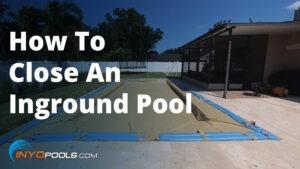A standard solar pool cover is a large sheet of UV-resistant plastic material designed to retain heat in pool water and prevent evaporation. The cover is typically placed over the pool when not in use and removed before swimming.
Here’s how they work:
- Heat Retention: The solar cover traps heat from the sun and transfers it to the pool water. This can help keep the pool water warmer and extend the swimming season, particularly in cooler climates. The cover acts like a greenhouse, allowing sunlight to pass through and heat the water but preventing the heat from escaping back into the air. The thicker the cover MIL, the better the cover’s insulation properties.
- Evaporation Prevention: The cover also helps to reduce water evaporation from the pool. When the pool water is exposed to air, some will evaporate, taking heat with it. The cover creates a barrier between the pool water and the air, reducing the water lost to evaporation.
Overall, a solar cover can help to reduce energy costs associated with heating a pool and can also help to reduce the need for pool chemicals by reducing the amount of water that needs to be added to the pool. Additionally, by reducing the amount of debris that enters the pool, the cover can also help to reduce the amount of time and effort required to clean the pool.
Solar Cover Colors

Solar blankets come in various colors, the most common being Blue and Clear (i count that as a color); the less common but still available solar blanket shades are black and silver.
- Clear Solar Covers – Allows the most sunlight, producing more “solar heating” than the more opaque covers.
- Blue Solar Covers – These are more UV resistant than clear solar covers, preventing chlorine burn-off.
- Black / Dark Blue Solar Covers – The most protection from UV rays and best for heat retention. Least useful for heat gain during sunny days.
Liquid Solar Blanket

A liquid solar blanket offers an alternative to pool owners who do not want or can’t physically maneuver the unwieldy solar blanket. Liquid Solar Blankets, like the SolarPill, create a film barrier on the pool’s surface, preventing water from evaporating and boasting some insulating qualities. The SolarPill’s formula is biodegradable, which will not clog pool equipment or affect swimmers. The efficacy of these liquid solar blankets is debatableat best. The evaporation rate comparison between standard solar covers and the liquid evaporation suppressants (LES) shows the liquid cover’s dismal performance.
Conclusion
In short: Yes they do. But they are best used in conjunction with a pool heater or heat pump. The solar cover’s insulation properties make sure the heat you put into the water, stays there.













Leave a Reply